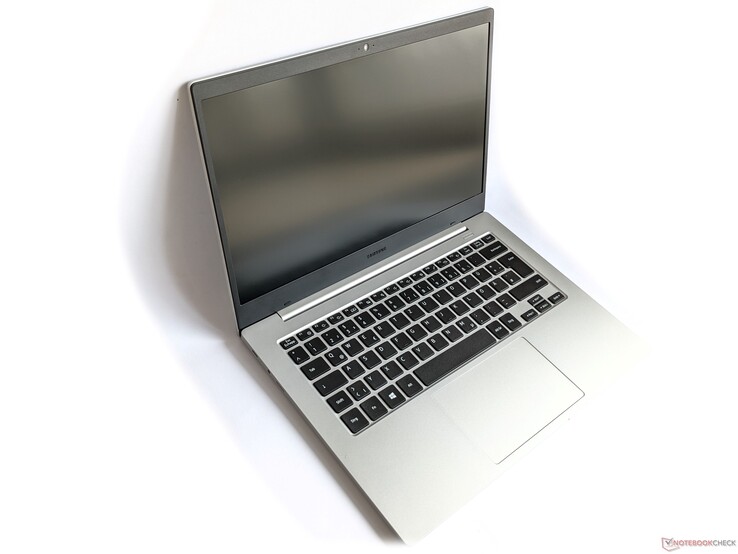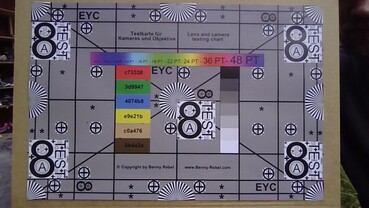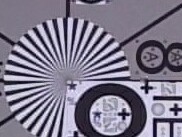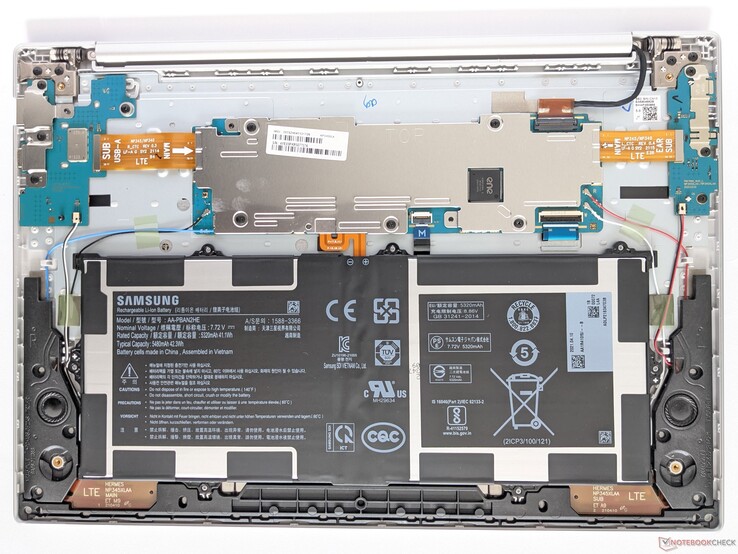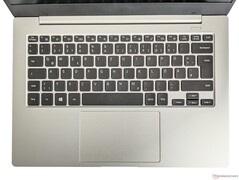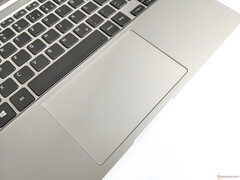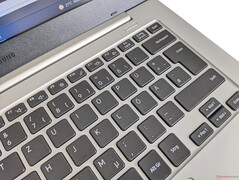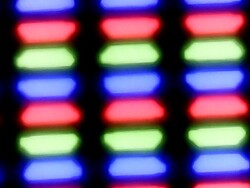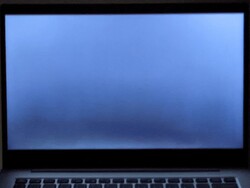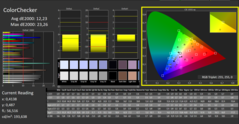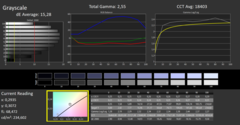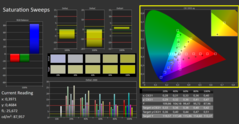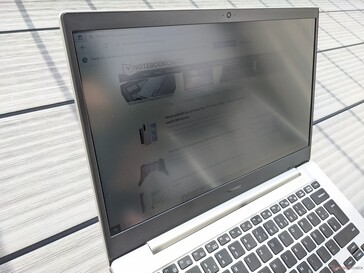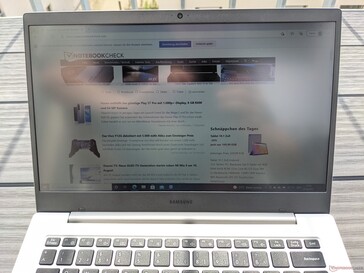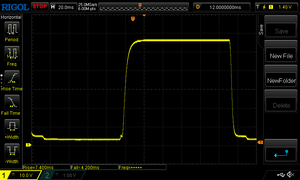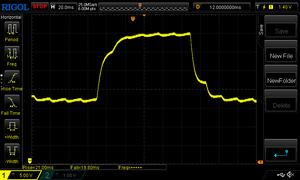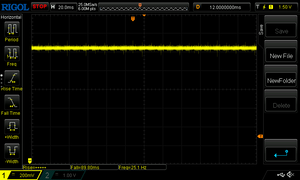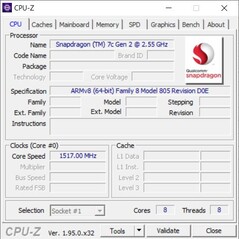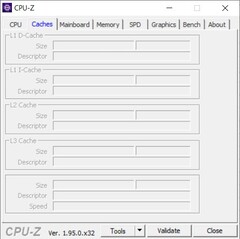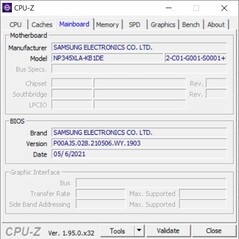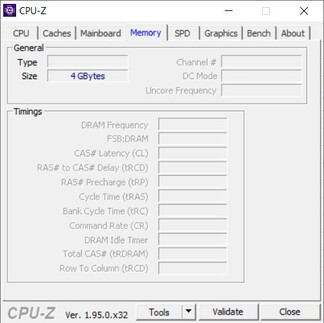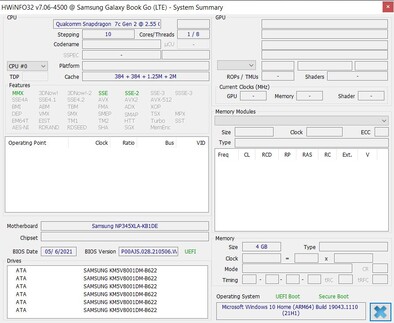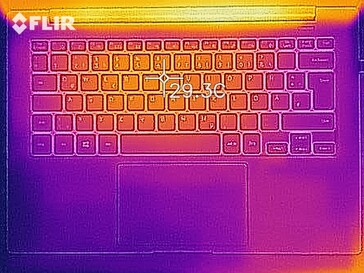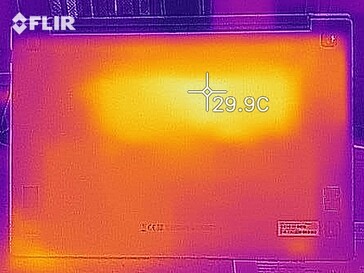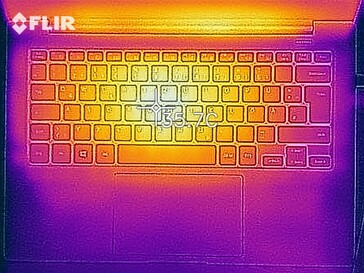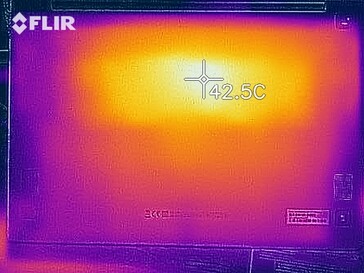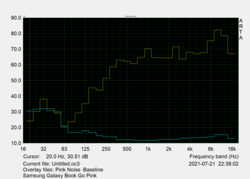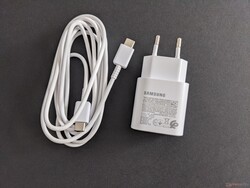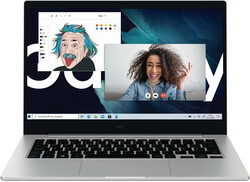Samsung Galaxy Book Go in review: Silent office notebook
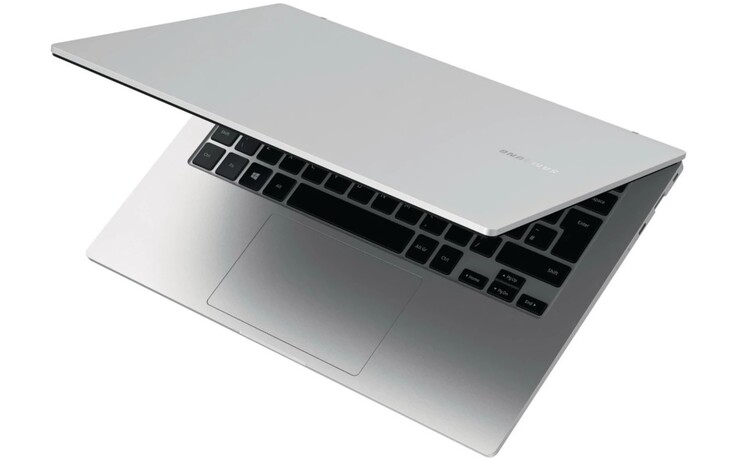
The Galaxy Book Go is not Samsung's first notebook with an ARM processor in our tests. Already the Galaxy Book S showed that this technology promises long battery runtimes and a performance suitable for everyday use. However, while the Book S was still in the higher-priced range, the Galaxy Book Go is comparatively inexpensive.
For less than 500 Euros (~$587), it is equipped with a Qualcomm Snapdragon 7c Gen 2 and its internal graphics unit, as well as 4 GB of RAM and a 128 GB UFS 2.1 storage. With this hardware, we compare the Galaxy Book Go with the rival devices listed below. Other notebooks from our database can also be added for comparison under each section.
Possible competitors in comparison
Rating | Date | Model | Weight | Height | Size | Resolution | Price |
|---|---|---|---|---|---|---|---|
| 79.3 % v7 (old) | 08 / 2021 | Samsung Galaxy Book Go SD 7c Gen 2, Adreno 618 | 1.4 kg | 15 mm | 14.00" | 1920x1080 | |
| 86.2 % v7 (old) | 06 / 2020 | Samsung Galaxy Book S SD 8cx, Adreno 680 | 951 g | 11.8 mm | 13.30" | 1920x1080 | |
| 79 % v7 (old) | 07 / 2021 | Chuwi CoreBook X i5-8259U, Iris Plus Graphics 655 | 1.5 kg | 20.6 mm | 14.00" | 2160x1440 | |
| 79.4 % v7 (old) | 10 / 2020 | Jumper Tech Ez Book X3 Air Celeron N4100, UHD Graphics 600 | 1.1 kg | 11 mm | 13.30" | 1920x1080 |
Case - Stable and light Samsung notebook
Samsung makes the top of the base and the lid of the Galaxy Book Go out of metal. The frame of the display and the base plate, on the other hand, are made of plastic. The notebook is well-made, looks stable and is very torsion-resistant. The display can also be folded back by up to 180 degrees and is held firmly in the respective position by the hinges.
Thanks to its narrow display bezel, the Galaxy Book Go is a very slim and compact device. The dimensions are on par with comparable notebooks. The weight of approximately 1.4 kilograms (~3.1 lb) is acceptable for this device class.
Equipment - Only a few ports on the Galaxy Book Go
The connectivity of Samsung's Galaxy Book Go is quite clear. The USB-C port on the right side is worth mentioning since it can also be used to connect an external monitor to the laptop. Other ports can also be connected via corresponding adapters or docking stations.
SDCardreader
The microSD card reader of Samsung's Galaxy Book Go achieves a good result when reading data with our reference memory card AV PRO microSD 128 GB V60. With a speed of 74.2 MB/s, it can claim second place in our test field.
| SD Card Reader - maximum AS SSD Seq Read Test (1GB) | |
| Samsung Galaxy Book S (Toshiba Exceria Pro M501 64 GB UHS-II) | |
| Average of class Office (25 - 249, n=26, last 2 years) | |
| Samsung Galaxy Book Go (AV PRO microSD 128 GB V60) | |
| Chuwi CoreBook X (AV PRO V60) | |
| Jumper Tech Ez Book X3 Air | |
Communication
The Galaxy Book Go can establish wireless connections via Wi-Fi 5, Bluetooth 5.1 and LTE. However, we only achieve comparatively slow data transfer rates with our reference router Netgear Nighthawk AX 12, which is only enough for the last place in our test field.
Webcam
Samsung also only installs a low-resolution webcam with 0.9 MP in its laptop, as is the case in most current devices. Accordingly, the picture quality is mediocre, which displays blurry images and too pale colors even in good lighting conditions.
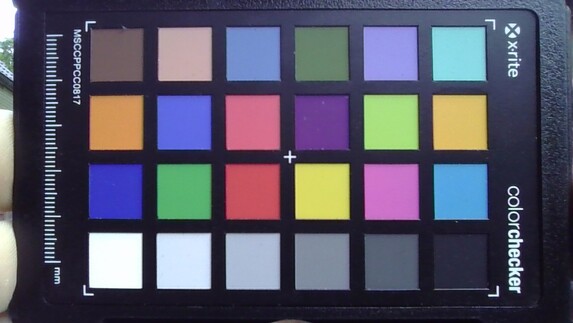
Accessories
Besides the laptop, only the power supply with the corresponding USB-C cable is included in the Samsung Galaxy Book Go's scope of delivery. Other general accessories can be purchased on the manufacturer's website.
Maintenance
The rubber feet on the bottom of the Galaxy Book Go are not glued but only plugged in. Therefore, they can be removed easily, which frees up access to the screws underneath. Once the latter have been loosened, the base plate can be removed. Inside the laptop, however, all components are soldered and thus cannot be exchanged or extended. The battery is screwed down and fans for cleaning are not present.
Warranty
Samsung grants a warranty period of 24 months for the Galaxy Book Go.
Input devices - Good keyboard for typing
Keyboard
The keys of the Galaxy Book Go offer a clear feedback when typing and are suitable for writing long texts effortlessly. The special keys are also relatively easy to reach, only the arrow keys seemed a bit too small to us. However, Samsung does not provide a backlight.
Touchpad
Display - Too dark, too pale and PWM
The screen of Samsung's Galaxy Book Go consists of a 14-inch TN panel with a resolution of 1920 x 1080 pixels. We measured a maximum brightness of 230 cd/m² in the center of the screen, but the drop to the edges is very high with, for example, only 184 cd/m² in the upper left corner. The illumination of only 80% is the lowest in our test field.
For the brightness control, PWM with a rather low frequency of 200 Hz is used with a luminosity of 20 percent. This can cause problems for people with sensitive eyes.
| |||||||||||||||||||||||||
Brightness Distribution: 80 %
Center on Battery: 230 cd/m²
Contrast: 639:1 (Black: 0.36 cd/m²)
ΔE ColorChecker Calman: 12.23 | ∀{0.5-29.43 Ø4.78}
ΔE Greyscale Calman: 15.28 | ∀{0.09-98 Ø5}
Gamma: 2.55
CCT: 18403 K
| Samsung Galaxy Book Go AUO203D, TN, 1920x1080, 14" | Samsung Galaxy Book S BOE, IPS, 1920x1080, 13.3" | Chuwi CoreBook X Chi Mei P140ZKA-BZ1, IPS, 2160x1440, 14" | Jumper Tech Ez Book X3 Air Sharp SHP1447, IPSJ390, 1920x1080, 13.3" | |
|---|---|---|---|---|
| Display | ||||
| Display P3 Coverage (%) | 67.2 | 65.5 | ||
| sRGB Coverage (%) | 98 | 95.6 | ||
| AdobeRGB 1998 Coverage (%) | 68.8 | 67.4 | ||
| Response Times | -90% | -66% | -84% | |
| Response Time Grey 50% / Grey 80% * (ms) | 40 ? | 48.8 ? -22% | 36.4 ? 9% | 41 ? -3% |
| Response Time Black / White * (ms) | 11 ? | 28.4 ? -158% | 26.4 ? -140% | 29 ? -164% |
| PWM Frequency (Hz) | 200 ? | 9524 ? | 10000 ? | 250 ? |
| Screen | 56% | 45% | 52% | |
| Brightness middle (cd/m²) | 230 | 383 67% | 355.3 54% | 355 54% |
| Brightness (cd/m²) | 201 | 355 77% | 344 71% | 330 64% |
| Brightness Distribution (%) | 80 | 88 10% | 94 18% | 88 10% |
| Black Level * (cd/m²) | 0.36 | 0.36 -0% | 0.34 6% | 0.275 24% |
| Contrast (:1) | 639 | 1064 67% | 1045 64% | 1291 102% |
| Colorchecker dE 2000 * | 12.23 | 3.1 75% | 6.2 49% | 5.92 52% |
| Colorchecker dE 2000 max. * | 23.26 | 5.3 77% | 10.96 53% | 10.41 55% |
| Greyscale dE 2000 * | 15.28 | 3.6 76% | 7.9 48% | 6.55 57% |
| Gamma | 2.55 86% | 2 110% | 2.02 109% | 2.06 107% |
| CCT | 18403 35% | 6743 96% | 7450 87% | 7661 85% |
| Colorchecker dE 2000 calibrated * | 1.23 | |||
| Color Space (Percent of AdobeRGB 1998) (%) | 61 | |||
| Color Space (Percent of sRGB) (%) | 96 | |||
| Total Average (Program / Settings) | -17% /
27% | -11% /
23% | -16% /
25% |
* ... smaller is better
The contrast ratio of 639:1 is very low and the black value of 0.36 cd/m² is also slightly higher. As a result, colors do not appear well delineated from each other and black image content appears with a gray haze.
The CalMAN analysis also shows that colors are displayed with a clear blue cast.
Display Response Times
| ↔ Response Time Black to White | ||
|---|---|---|
| 11 ms ... rise ↗ and fall ↘ combined | ↗ 7 ms rise | |
| ↘ 4 ms fall | ||
| The screen shows good response rates in our tests, but may be too slow for competitive gamers. In comparison, all tested devices range from 0.1 (minimum) to 240 (maximum) ms. » 28 % of all devices are better. This means that the measured response time is better than the average of all tested devices (20.2 ms). | ||
| ↔ Response Time 50% Grey to 80% Grey | ||
| 40 ms ... rise ↗ and fall ↘ combined | ↗ 21 ms rise | |
| ↘ 19 ms fall | ||
| The screen shows slow response rates in our tests and will be unsatisfactory for gamers. In comparison, all tested devices range from 0.165 (minimum) to 636 (maximum) ms. » 60 % of all devices are better. This means that the measured response time is worse than the average of all tested devices (31.6 ms). | ||
Screen Flickering / PWM (Pulse-Width Modulation)
| Screen flickering / PWM detected | 200 Hz | ≤ 20 % brightness setting | |
The display backlight flickers at 200 Hz (worst case, e.g., utilizing PWM) Flickering detected at a brightness setting of 20 % and below. There should be no flickering or PWM above this brightness setting. The frequency of 200 Hz is relatively low, so sensitive users will likely notice flickering and experience eyestrain at the stated brightness setting and below. In comparison: 53 % of all tested devices do not use PWM to dim the display. If PWM was detected, an average of 8118 (minimum: 5 - maximum: 343500) Hz was measured. | |||
The TN panel installed by Samsung is not viewing-angle stable, which means that image content appears with clearly distorted colors when viewed from the side. Therefore, you have to look at the display as straight as possible in everyday use, since the display already deviates from angles of about 45 degrees.
Performance - Samsung notebook suitable for office programs
The Galaxy Book Go is a laptop for people with low demands on performance. The installed Qualcomm Snapdragon 7c Gen 2 is suitable for simple office applications and web browsing. Media playback is also possible without problems. However, even simple multi-tasking shows short waiting times. The system also stalled occasionally, for example when an external hard drive was connected.
Processor
The aforementioned behavior is reflected by low results in the benchmarks. The performance is comparable with that of an Intel Celeron N4100 whereby the latter scores slightly worse in the CPU tests, but slightly better in the GPU tests.
Since the Snapdragon 7c Gen 2 is an ARM processor, only 64-bit applications natively compiled for ARM can be run. A 64-bit Windows emulation for x86 apps has already been announced, but it is not yet known when it will be available. Therefore, you should check whether the required applications are also available as a 32-bit version before buying the notebook.
Of the benchmarks performed, only Geekbench 5.3 ran as native ARM applications. The rest of the tests were emulated, which can lead to a lower result than would be the case with native applications. We have shown which performance other processors offer in comparison in our CPU benchmark list listed.
Geekbench 4.4: 64 Bit Multi-Core Score | 64 Bit Single-Core Score
3DMark 11: 1280x720 Performance GPU
WebXPRT 3: Overall
JetStream 1.1: Total Score
Jetstream 2: 2.0 Total Score
Mozilla Kraken 1.1: Total
Octane V2: Total Score
| Geekbench 5.5 / Multi-Core | |
| Average of class Office (1719 - 16999, n=78, last 2 years) | |
| Average Qualcomm Snapdragon 7c Gen 2 (1630 - 5337, n=2) | |
| HP EliteBook Folio 13.5-3G2L2EA | |
| Samsung Galaxy Book S | |
| Samsung Galaxy Book Go | |
| Jumper Tech Ez Book X3 Air | |
| Geekbench 5.5 / Single-Core | |
| Average of class Office (811 - 2128, n=78, last 2 years) | |
| Average Qualcomm Snapdragon 7c Gen 2 (556 - 1537, n=2) | |
| HP EliteBook Folio 13.5-3G2L2EA | |
| Samsung Galaxy Book S | |
| Samsung Galaxy Book Go | |
| Jumper Tech Ez Book X3 Air | |
| Geekbench 4.4 / 64 Bit Multi-Core Score | |
| Average of class Office (16566 - 41544, n=10, last 2 years) | |
| Samsung Galaxy Book S | |
| HP EliteBook Folio 13.5-3G2L2EA | |
| Samsung Galaxy Book Go | |
| Average Qualcomm Snapdragon 7c Gen 2 (n=1) | |
| Geekbench 4.4 / 64 Bit Single-Core Score | |
| Average of class Office (4469 - 8042, n=10, last 2 years) | |
| Samsung Galaxy Book S | |
| HP EliteBook Folio 13.5-3G2L2EA | |
| Samsung Galaxy Book Go | |
| Average Qualcomm Snapdragon 7c Gen 2 (n=1) | |
| 3DMark 11 / Performance GPU | |
| Average of class Office (1468 - 16418, n=70, last 2 years) | |
| Chuwi CoreBook X | |
| HP EliteBook Folio 13.5-3G2L2EA | |
| Samsung Galaxy Book S | |
| Jumper Tech Ez Book X3 Air | |
| Samsung Galaxy Book Go | |
| Average Qualcomm Snapdragon 7c Gen 2 (572 - 599, n=2) | |
| WebXPRT 3 / Overall | |
| Average of class Office (121 - 455, n=77, last 2 years) | |
| Chuwi CoreBook X | |
| HP EliteBook Folio 13.5-3G2L2EA | |
| Samsung Galaxy Book S | |
| Samsung Galaxy Book Go | |
| Average Qualcomm Snapdragon 7c Gen 2 (n=1) | |
| JetStream 1.1 / Total Score | |
| HP EliteBook Folio 13.5-3G2L2EA | |
| Samsung Galaxy Book S | |
| Samsung Galaxy Book Go | |
| Average Qualcomm Snapdragon 7c Gen 2 (n=1) | |
| Jetstream 2 / 2.0 Total Score | |
| Average of class Office (74.4 - 452, n=22, last 2 years) | |
| Chuwi CoreBook X | |
| HP EliteBook Folio 13.5-3G2L2EA | |
| Samsung Galaxy Book S | |
| Samsung Galaxy Book Go | |
| Average Qualcomm Snapdragon 7c Gen 2 (n=1) | |
| Mozilla Kraken 1.1 / Total | |
| Average Qualcomm Snapdragon 7c Gen 2 (1819 - 3989, n=2) | |
| Jumper Tech Ez Book X3 Air | |
| Samsung Galaxy Book Go | |
| Samsung Galaxy Book S | |
| HP EliteBook Folio 13.5-3G2L2EA | |
| Chuwi CoreBook X | |
| Average of class Office (391 - 1966, n=81, last 2 years) | |
| Octane V2 / Total Score | |
| Average of class Office (22414 - 122119, n=19, last 2 years) | |
| HP EliteBook Folio 13.5-3G2L2EA | |
| Samsung Galaxy Book S | |
| Samsung Galaxy Book Go | |
| Average Qualcomm Snapdragon 7c Gen 2 (n=1) | |
* ... smaller is better
Mass storage
Samsung installs a 128 GB UFS 2.1 storage in the Galaxy Book Go, as it is also used in smartphones, for example. Although it achieves good read and write speeds for its class in the storage benchmarks, it cannot keep up even with inexpensive SSDs in our test field.
To compare the performance offered in other mass storage devices, see our HDD/SSD benchmark list.
| Samsung Galaxy Book Go 128 GB UFS 2.1 Flash | Samsung Galaxy Book S 256 GB NVMe | Chuwi CoreBook X Kingston RBUSNS8154P3512GJ | Jumper Tech Ez Book X3 Air 128 GB NVMe | Average 128 GB UFS 2.1 Flash | |
|---|---|---|---|---|---|
| CrystalDiskMark 5.2 / 6 | 66% | 469% | 78% | 0% | |
| Write 4K (MB/s) | 19.67 | 30.59 56% | 130.5 563% | 54.2 176% | 19.7 ? 0% |
| Read 4K (MB/s) | 17.69 | 20.26 15% | 38.72 119% | 9.892 -44% | 17.7 ? 0% |
| Write Seq (MB/s) | 211.8 | 421.4 99% | 709 235% | 391.3 85% | 212 ? 0% |
| Read Seq (MB/s) | 430.1 | 1232 186% | 717 67% | 403.6 -6% | 430 ? 0% |
| Write 4K Q32T1 (MB/s) | 41.47 | 39.17 -6% | 510 1130% | 122.3 195% | 41.5 ? 0% |
| Read 4K Q32T1 (MB/s) | 48.17 | 41.14 -15% | 554 1050% | 96.1 100% | 48.2 ? 0% |
| Write Seq Q32T1 (MB/s) | 210.1 | 420.9 100% | 1037 394% | 464.3 121% | 210 ? 0% |
| Read Seq Q32T1 (MB/s) | 541 | 1047 94% | 1609 197% | 539 0% | 541 ? 0% |
| AS SSD | 54% | 220% | -22% | 0% | |
| Seq Read (MB/s) | 449 | 1069 138% | 1393 210% | 469.7 5% | 449 ? 0% |
| Seq Write (MB/s) | 185.2 | 382 106% | 954 415% | 422.9 128% | 185.2 ? 0% |
| 4K Read (MB/s) | 16.56 | 16.64 0% | 39.51 139% | 18.01 9% | 16.6 ? 0% |
| 4K Write (MB/s) | 38.97 | 35.99 -8% | 98.9 154% | 40.29 3% | 39 ? 0% |
| 4K-64 Read (MB/s) | 257.4 | 415.1 61% | 834 224% | 94.5 -63% | 257 ? 0% |
| 4K-64 Write (MB/s) | 153.2 | 229.5 50% | 687 348% | 194.6 27% | 153.2 ? 0% |
| Access Time Read * (ms) | 0.282 | 0.066 77% | 0.437 -55% | 0.282 ? -0% | |
| Access Time Write * (ms) | 0.117 | 0.093 21% | 0.044 62% | 0.41 -250% | 0.117 ? -0% |
| Score Read (Points) | 319 | 539 69% | 1013 218% | 159 -50% | 319 ? 0% |
| Score Write (Points) | 211 | 304 44% | 881 318% | 277 31% | 211 ? 0% |
| Score Total (Points) | 684 | 1086 59% | 2399 251% | 523 -24% | 684 ? 0% |
| Total Average (Program / Settings) | 60% /
59% | 345% /
325% | 28% /
20% | 0% /
0% |
* ... smaller is better
Gaming performance
For the display of image content, the Galaxy Book Go has the internal Qualcomm Adreno 618. It is only suitable for displaying simple games from the Windows Store, and long loading times have to be expected here as well. In our review of Asphalt 8, a smooth gameplay was interrupted by occasional stutters.
Emissions - Silent notebook from Samsung
Noise emissions
The Samsung notebook is cooled passively and is therefore silent. We could not detect any other noises, such as coil whine or similar, in our test device.
Temperature
According to our measurements, the Galaxy Book Go heats up to 41.6 °C (~107 °F) under load. Thus, the laptop only heats up moderately and can be used on the thighs, for example, without any problems. The temperatures of the palm rests are also within a moderate range with a maximum of 26 °C (~79 °F).
(+) The maximum temperature on the upper side is 35.4 °C / 96 F, compared to the average of 34.3 °C / 94 F, ranging from 21.2 to 62.5 °C for the class Office.
(±) The bottom heats up to a maximum of 41.6 °C / 107 F, compared to the average of 36.8 °C / 98 F
(+) In idle usage, the average temperature for the upper side is 23.8 °C / 75 F, compared to the device average of 29.5 °C / 85 F.
(+) The palmrests and touchpad are cooler than skin temperature with a maximum of 24.5 °C / 76.1 F and are therefore cool to the touch.
(+) The average temperature of the palmrest area of similar devices was 27.6 °C / 81.7 F (+3.1 °C / 5.6 F).
Speaker
The speakers of the Galaxy Book Go offer a relatively high volume and a sound spectrum that is pronounced on the high tones. Thus, the Samsung notebook is suitable for playing voice content. However, external speakers or headphones should be preferred for more complex audio content.
Samsung Galaxy Book Go audio analysis
(+) | speakers can play relatively loud (82.2 dB)
Bass 100 - 315 Hz
(-) | nearly no bass - on average 20.5% lower than median
(±) | linearity of bass is average (12.5% delta to prev. frequency)
Mids 400 - 2000 Hz
(+) | balanced mids - only 1.7% away from median
(+) | mids are linear (5.3% delta to prev. frequency)
Highs 2 - 16 kHz
(±) | higher highs - on average 6.5% higher than median
(±) | linearity of highs is average (9.9% delta to prev. frequency)
Overall 100 - 16.000 Hz
(±) | linearity of overall sound is average (18.1% difference to median)
Compared to same class
» 30% of all tested devices in this class were better, 6% similar, 64% worse
» The best had a delta of 7%, average was 21%, worst was 53%
Compared to all devices tested
» 37% of all tested devices were better, 8% similar, 55% worse
» The best had a delta of 4%, average was 24%, worst was 134%
Samsung Galaxy Book S audio analysis
(±) | speaker loudness is average but good (79.2 dB)
Bass 100 - 315 Hz
(±) | reduced bass - on average 10.7% lower than median
(±) | linearity of bass is average (9.7% delta to prev. frequency)
Mids 400 - 2000 Hz
(+) | balanced mids - only 3.8% away from median
(+) | mids are linear (3.9% delta to prev. frequency)
Highs 2 - 16 kHz
(+) | balanced highs - only 2.1% away from median
(+) | highs are linear (2.2% delta to prev. frequency)
Overall 100 - 16.000 Hz
(+) | overall sound is linear (14.8% difference to median)
Compared to same class
» 31% of all tested devices in this class were better, 6% similar, 64% worse
» The best had a delta of 5%, average was 18%, worst was 53%
Compared to all devices tested
» 19% of all tested devices were better, 4% similar, 77% worse
» The best had a delta of 4%, average was 24%, worst was 134%
Power management - Laptop with long battery life
Power consumption
| Off / Standby | |
| Idle | |
| Load |
|
Key:
min: | |
| Samsung Galaxy Book Go SD 7c Gen 2, Adreno 618, 128 GB UFS 2.1 Flash, TN, 1920x1080, 14" | Samsung Galaxy Book S SD 8cx, Adreno 680, 256 GB NVMe, IPS, 1920x1080, 13.3" | Chuwi CoreBook X i5-8259U, Iris Plus Graphics 655, Kingston RBUSNS8154P3512GJ, IPS, 2160x1440, 14" | Jumper Tech Ez Book X3 Air Celeron N4100, UHD Graphics 600, 128 GB NVMe, IPSJ390, 1920x1080, 13.3" | Average Qualcomm Adreno 618 | Average of class Office | |
|---|---|---|---|---|---|---|
| Power Consumption | -23% | -236% | -73% | 41% | -235% | |
| Idle Minimum * (Watt) | 1.9 | 1.61 15% | 6.2 -226% | 3.4 -79% | 1.031 ? 46% | 4.52 ? -138% |
| Idle Average * (Watt) | 4.2 | 4.3 -2% | 10.7 -155% | 6.9 -64% | 2.47 ? 41% | 7.5 ? -79% |
| Idle Maximum * (Watt) | 4.8 | 5 -4% | 12.5 -160% | 7.4 -54% | 2.72 ? 43% | 8.9 ? -85% |
| Load Average * (Watt) | 8.2 | 13.2 -61% | 40.5 -394% | 17 -107% | 5.09 ? 38% | 42.3 ? -416% |
| Load Maximum * (Watt) | 11.4 | 18.3 -61% | 39.2 -244% | 18.5 -62% | 7.36 ? 35% | 63.6 ? -458% |
| Witcher 3 ultra * (Watt) | 39.4 |
* ... smaller is better
Battery life
Samsung's notebook achieves a runtime of almost 13 hours in our practical WLAN test. It thus achieves a very good rate and is only surpassed by Samsung's Galaxy Book S in our test field.
The battery of the Galaxy Book Go is fully recharged after about one and a half hours with the included power adapter.
| Samsung Galaxy Book Go SD 7c Gen 2, Adreno 618, 41.1 Wh | Samsung Galaxy Book S SD 8cx, Adreno 680, 42 Wh | Chuwi CoreBook X i5-8259U, Iris Plus Graphics 655, 46.2 Wh | Jumper Tech Ez Book X3 Air Celeron N4100, UHD Graphics 600, Wh | Average of class Office | |
|---|---|---|---|---|---|
| Battery runtime | 13% | -48% | -43% | -36% | |
| WiFi v1.3 (h) | 13 | 15.9 22% | 6.7 -48% | 7.4 -43% | 12.6 ? -3% |
| Load (h) | 6 | 6.2 3% | 1.849 ? -69% |
Pros
Cons
Verdict - Sufficient for simple demands
With the Galaxy Book Go, Samsung supplies an inexpensive notebook with an ARM processor. If it is only used for office programs and surfing the Internet, there should not be any problems due to incompatible programs in everyday use. The performance is sufficient to run applications within the mentioned scope. However, the system can slow down if several programs are used at the same time.
A better display could have made the Samsung Galaxy Book Go a good and inexpensive notebook.
Due to the low price, a not too fast running system would not be an issue, though. However, since Samsung also saves on the display, the Galaxy Book Go becomes a rather mediocre notebook compared to other notebooks in this price range. The extremely low contrast ratio and the strong viewing angle instability are not particularly pleasant for the eyes.
The cheap competition from China has made a name for itself with devices like the Jumper Tech EZbook X3 Air and the Chuwi CoreBook X, some of which are even cheaper and offer a better screen. The battery life is shorter here, but what use is 13 hours of runtime when you cannot look at the display for that long?
Price and availability
The Samsung Galaxy Book Go is available now and can be purchased for about $319.99 (~$375), for example, on Amazon.
Samsung Galaxy Book Go
- 08/11/2021 v7 (old)
Mike Wobker




